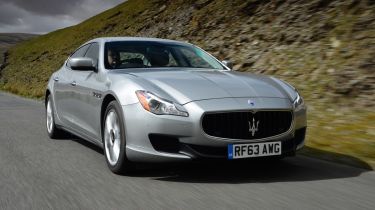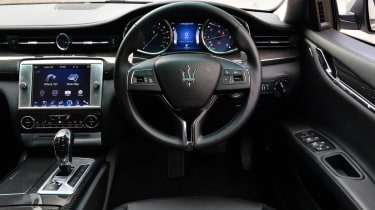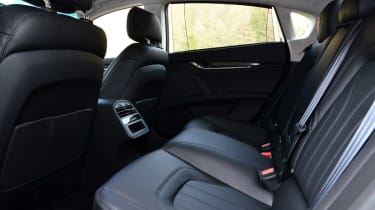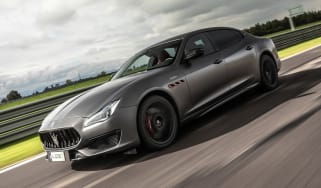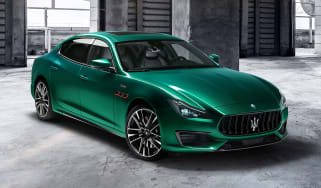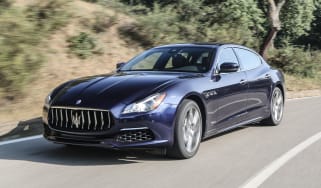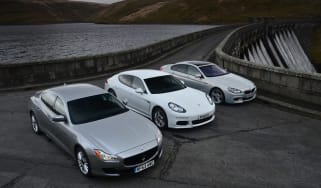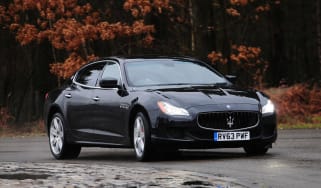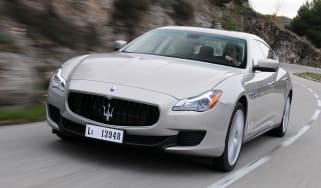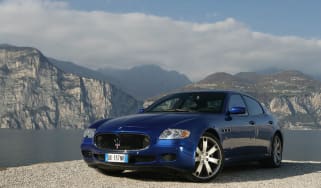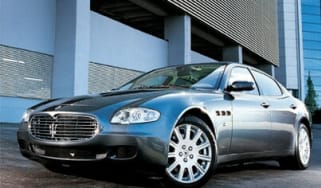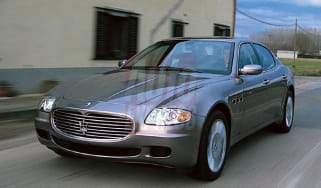Maserati Quattroporte review
If you want a sporty limousine, the Maserati Quattroporte offers something distinctly different

The Maserati Quattroporte sounds terrifically exotic, and the literal English translation is 'four-door'. But just like the name, the car itself adds a thick dollop of Italian verve to the four-door limousine formula.
It has eye-catching, sporty looks, although not everyone will be a fan of the exterior styling. Inside though, the big Italian delivers elegant design and enough luxury and opulence to pamper even the most demanding captain of industry.
The petrol engines provide staggering performance to rival sporty German limos, but sadly the chassis isn’t a match for them. There is a diesel, too, and while it doesn’t have the same magic or charm as the petrol models, it makes more financial sense and is almost as engaging.
In some ways the Maserati Quattroporte is a rapid grand touring sports car that just happens to be wrapped in a low-slung limousine-style body. It's the latest in a long line of Quattroporte models that have been built by the firm from Modena, Italy, all of which have combined sports car handling with upmarket four-seater luxury.
The original Quattroporte was launched in 1963 as a standalone model, and its name is the Italian for 'four-door' - it's difficult to imagine a British firm like Aston Martin or Jaguar building a car simply called Fourdoor...
Used - available now

2022 Abarth
595
26,293 milesManualPetrol1.4L
Cash £15,700
2021 Jaguar
XE
45,309 milesAutomaticPetrol2.0L
Cash £21,300
2022 Nissan
Qashqai
11,077 milesAutomaticPetrol1.3L
Cash £18,499
2023 Tesla
Model Y
64,942 milesAutomaticElectric
Cash £21,500The Quattroporte was a stylish rear-wheel drive saloon capable of 124mph, but the Quattroporte II was less successful. It arrived in 1976 at the height of the oil crisis, while Maserati's then-owner Citroen based the second version on an extended Citroen SM platform, so it was front-wheel drive and had hydropneumatic suspension. It wasn't a success, with only 13 built, and ultimately bankrupted the company.
The third Quattroporte arrived in 1979 and went back to the Mk1's front engine V8/rear-drive layout, and had angular styling that was popular at the time. It remained on sale for a decade. The Mk4 from 1994 was a radical departure, as it shrank from being a Mercedes S-Class rival to an alternative to the BMW M5 and Mercedes E55 AMG.
In 1997 Ferrari took a stake in Maserati, and under its guidance, the Quattroporte returned to the limo class for the Mk5 model. All versions were powered by a Ferrari-developed V8, while the car went through a series of updates to boost luxury and performance throughout its production run, from 2003-2012.
The sixth generation Quattroporte arrived in 2013, and it's larger, lighter and more efficient than the car it replaced. One major change for this generation is the expansion in engine options. Not only is there a Ferrari-developed twin-turbo V8, but there's also a twin-turbo V6 petrol and a 3.0-litre V6 diesel. All three engines come with an eight-speed automatic gearbox.
There was an update to the range in 2016, with new technology on-board borrowed from the newly launched Levante SUV, while the engines gained improved efficiency. The range was also revised to include two new trims. There's the basic 3.0 Diesel and 3.0 V6 S petrol models, while you can upgrade to GranLusso or GranSport trims. The V8 GTS comes in either GranLusso or GranSport trim as standard. Prices start from just over £70,000 and rise to £116,000, although you can go above and beyond that with options.
Rivals for the Maserati Quattroporte are varied, but mostly sporting. The new Porsche Panamera trades on sporting luxury, while the Jaguar XJ and Mercedes S-Class are offered in sporty variants. The BMW 7 Series is a technological showcase, while the Tesla Model S is an intriguing alternative choice. Other models to consider include the Audi S8 and Aston Martin Rapide S.
Engines, performance and drive
With 50:50 weight distribution, a long wheelbase and a rear-wheel-drive chassis, the Maserati Quattroporte promises much. However, on a twisty road it just isn’t as good as its rivals.
The steering gives you little sense of what the front wheels are doing, and with artificial and inconsistent weighting as you go from lock-to-lock, you find yourself making small corrections and counter adjustments. You can’t be precise at turn-in and you don’t have confidence through a corner.
The limit of grip arrives suddenly, which combined with the lifeless steering, means the Maserati doesn’t feel as composed as its rivals. On poor surfaces, the chassis wriggles, feeling unsettled over roads that its competitors soak up with ease.
Even with the Skyhook dampers in Normal mode, the ride is unresolved. Initial damping is okay, but the 19-inch wheels thump into imperfections. Sport mode stiffens the suspension without improving control. It sharpens the throttle response, speeds up gearshifts and opens the exhaust valves, but Maserati’s Active Sound system generates a mechanical grinding rather than an attractive exhaust note.
Engines
The V8-powered Quattroporte offers the kind of acceleration you’d normally associate with supercars rather than large limousines.
Acceleration from 0-62mph takes just 4.7 seconds and there's huge amounts of torque from under 2,000rpm all the way up to 7,500rpm, meaning in-gear punch is always impressive. The claimed top speed is 190mph, and a deep growl from the exhausts means people will definitely hear you coming long before they see you.
The turbocharged V6 model doesn't sound quite as good as the V8 but still feels very fast – the official 0-62mph time is 5.1 seconds while top speed is 177mph.
The diesel-engined Quattroporte is a bit too clattery at idle, but becomes more refined once you get up to speed. It has a top speed of 155mph and will do 0-62mph in 6.4 seconds, so it’s still pretty quick for such a big car.
MPG, CO2 and running costs
Fuel economy for the V8 engine is a huge improvement over the old car’s 15.7mpg figure. With a smaller capacity and a couple of turbos, the 3.8-litre V8 manages 26.4mpg and CO2 emissions of 250g/km.
If you drive it hard though then expect that figure to fall dramatically. The V6 is not much better at 29.4mpg combined so the diesel is really the only option if you are planning many long journeys. It returns an impressive 45.6mpg and emits a tax-friendly 163g/km of CO2, making it competitive with the other diesels in the executive class.
However, the 80-litre fuel tank won’t last that long on the petrol models and you’ll be shelling out over £100 to fill an empty tank.
As you would expect, insurance premiums are going to be sky high and servicing costs will be befitting of a car with a price tag of more than £100,000.
The diesel is a bit more accessible at £69,000 but with a long optional equipment list it would be easy to quickly send the price rocketing upwards.
Servicing is expensive as well, and Maserati only has around 20 dealers in the UK.
Insurance groups
Due to its price and performance, you’ll be facing stiff insurance premiums for all versions of the Quattroporte.
Depreciation
Most big and expensive luxury cars suffer from brutal depreciation, but traditionally, big and expensive Maserati saloons have suffered more. This will be a concern for private buyers especially.
Our used car valuation experts CAP paint a pretty woeful picture of residual values after a typical three-year/30,000 mile period of ownership. The worst offender is the most expensive GTS model, which CAP predicts will retain just 28 per cent of its new price. Using the same prediction parameters, the V6 petrol will retain 35 per cent and the diesel model 37 per cent.
By way of comparison, the Mercedes-AMG S-Class should be worth up to 40 per cent of its new cost according to the CAP predictions.
Interior, design and technology
A Maserati has to be stylish, but the Quattroporte’s looks divide opinion. While the last generation was penned by styling maestro Pininfarina, this model was designed in-house – and although there are some nice details, it’s arguably not as distinctive or as beautiful as a Maserati should be.
The low snout and trident-badged grille are matched to slender GranTurismo-inspired headlights and LED running lights to give the car a dramatic face. The trio of fake air vents on the front wings are a typical Maserati touch. Yet the lines at the rear could be from a Hyundai saloon, plus the Maserati looks bloated in profile, compared to its shorter and lower rivals. LED rear light clusters lift the feel at the rear a little, while the frameless door glass is an unusual touch in the luxury saloon segment too.
Inside, first impressions are good. The Quattroporte has a decent layout and the chrome-ringed dials and smart multifunction wheel give it an upmarket feel. There’s a real wow factor to sitting in a car with the famous trident badge and the classic egg-shaped clock sitting in the middle of the tapering dashboard is a classy touch. However, look closely and you’ll find hard plastics and cheap switchgear, which dilutes the luxury feel a little.
On the plus side, standard kit includes eight-way adjustable electric seats, ambient cabin lighting and adaptive cruise control. There are also plenty of ways to personalise your Quattroporte, with five different wood species for the dashboard and door inserts, and a variety of leather choices.
Sat-nav, stereo and infotainment
The Quattroporte has an impressive 8.4-inch touchscreen display at the centre of the console, and there are upgraded audio options from both Bowers and Wilkins and Harmon Kardon. The latter has 10 speakers and is pretty impressive, but the Bowers and Wilkins set-up features 15 speakers and a 16-channel 1,280-Watt amplifier.
Practicality, comfort and boot space
The Quattroporte is larger than the model that preceded it, and has a longer wheelbase and wider body than its key rivals.
Thanks to its extremely luxurious and well-appointed cabin there’ll be few complaints from occupants, especially as the seats are very well designed and cushioned. Although the ride quality isn’t as isolating from bumps as the best in its class, it’s still an extremely comfortable car to travel in.
Dimensions and size
The Quattroporte looks big and imposing, and it is. The car measures 5,263mm from bumper to bumper, and it’s 1,948mm wide too. Height is 1,481mm.
To put that into perspective, the Porsche Panamera is 5,015mm long by 1,931mm wide, the Aston Martin Rapide is 5,019mm by 1,929mm, and the Mercedes S-Class is 5,246mm by 1,899mm. If you want something bigger, you’ll need to spend a lot more money on something like the 5,575mm x 1,926mm Bentley Mulsanne.
Leg room, head room & passenger space
As you’d expect for a car designed to chauffeur captains of Italian industry, the Quattroporte offers plenty of head and legroom.
In fact there’s an extra 107mm of cabin space over the previous model. The rear bench with three seats comes as standard, although the middle chair is high and hard, while the big transmission tunnel means you’d only want to carry three people in the back occasionally.
Alternatively, you could always opt for the £4,440 individual two-seat layout, which adds extra luxuries like electric adjustment, ventilation and front passenger seat movement. Powered rear sunblinds are standard and for an eye-watering £2,100 you can add folding tray tables. Privacy glass costs £1,128 and heated rear seats are £348 extra.
Boot space
There’s plenty of luggage space in the back of the Quattroporte: the 530-litre boot is 80 litres up on the old car’s. Plus, the rear seats can be folded if you need to carry longer items.
Reliability and safety
Maserati didn’t record a big enough sample size to feature in our Driver Power 2016 satisfaction survey. It’s certainly true the brand used to have a reputation for fearsome unreliability and dreadful build quality, but the latest Quattroporte feels very well put together and features plenty of well proven components, like the eight-speed ZF box.
The powerful diesel is the same VM Motori engine which is used in the Chrysler 300C and Jeep Grand Cherokee, while the platform is also shared with the Ghibli. The two petrol engines were both new for the Quattroporte’s launch, but overall we wouldn’t expect the Maserati ownership experience to be very different from other cars in its class in respect of reliability.
Maserati offers a three-year unlimited mileage warranty should anything go wrong, but the very small number of UK dealers may be off-putting – and a real pain if you there isn’t one nearby when you need it. There are around 20 listed on Maserati’s UK website, which is stretching things a bit thin.
The Quattroporte’s standard safety equipment includes window airbags and a reversing camera.
The Quattroporte hasn't been crash-tested by Euro NCAP, but it's the same story for high-end rivals like the Aston Martin Rapide, Mercedes-Benz S-Class and the Porsche Panamera. However a generous number of airbags and high-tech construction should ensure the Quattroporte performs well. It also comes with plenty of active and passive safety systems that are common place on cars this size.
Warranty
The Maserati standard warranty applies to the Quattroporte, which means three-years unlimited mileage cover. Most of the car’s rivals attract similar cover.
Servicing
Sadly Maserati doesn’t attract the same seven-year free servicing deal as its former Fiat-Chrysler stablemate Ferrari. There are no fixed price deals either, so servicing is likely to be an expensive experience.
